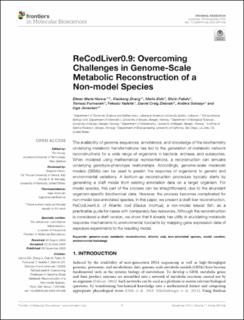ReCodLiver0.9: Overcoming Challenges in Genome-Scale Metabolic Reconstruction of a Non-model Species
Hanna, Eileen Marie; Zhang, Xiaokang; Eide, Marta; Fallahi, Shirin; Furmanek, Tomasz; Yadetie, Fekadu; Zielinski, Daniel Craig; Goksøyr, Anders; Jonassen, Inge
Peer reviewed, Journal article
Published version

View/
Date
2020Metadata
Show full item recordCollections
- Articles [3012]
- Publikasjoner fra CRIStin [3066]
Abstract
The availability of genome sequences, annotations, and knowledge of the biochemistry underlying metabolic transformations has led to the generation of metabolic network reconstructions for a wide range of organisms in bacteria, archaea, and eukaryotes. When modeled using mathematical representations, a reconstruction can simulate underlying genotype-phenotype relationships. Accordingly, genome-scale metabolic models (GEMs) can be used to predict the response of organisms to genetic and environmental variations. A bottom-up reconstruction procedure typically starts by generating a draft model from existing annotation data on a target organism. For model species, this part of the process can be straightforward, due to the abundant organism-specific biochemical data. However, the process becomes complicated for non-model less-annotated species. In this paper, we present a draft liver reconstruction, ReCodLiver0.9, of Atlantic cod (Gadus morhua), a non-model teleost fish, as a practicable guide for cases with comparably few resources. Although the reconstruction is considered a draft version, we show that it already has utility in elucidating metabolic response mechanisms to environmental toxicants by mapping gene expression data of exposure experiments to the resulting model.